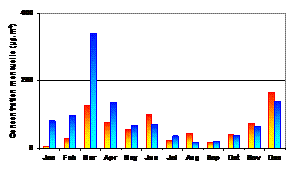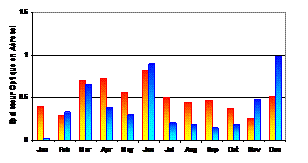Regional 3D modeling with CHIMERE-Dust
The CHIMERE-Dust model, adapted from the CHIMERE chemistry-transport model, is a numerical tool dedicated to the description of the atmospheric cycle of mineral dust aerosols from arid regions. This model has a fine resolution both in time (hourly resolution) and space (resolution ~ tens of kilometers), yet allows for multi-year simulations (~ 10 years). The inclusion of the emission model of LISA and the use of adapted surface databases allows the simulation “online” of emission fluxes and of the size distribution of the emitted aerosol. Taking into account the size distribution particularly towards the representation of the deposition process has also been the subject of an original parameterization [Foret et al., 2006].
A first phase of validation of CHIMERE-Dust was to confront the simulations of measurements performed on the Sahelian transect and to assess its ability to reproduce quantitatively the aerosol optical thickness, the surface concentrations and the vertical distribution of the dust layers as well as their seasonal variability [Schmechtig et al., 2011]. Ground-based measurements can be used as points of constraint on the dust size distribution at emission and after transport, on size-resolved deposition rates, on the emission fluxes. Ground and airborne measurements obtained on cases of Saharan aerosol transport allow testing the ability of the model to reproduce the emissions from the identified sources, the extension and the speed of the plumes, the evolution of particle size during transport and the vertical distribution of aerosol layers. The representation of the terms of deposition, and therefore of mass balance, will be constrained by using measurements of the deposition performed along the Sahelian Dust transect as well as in the transport regions of the Mediterranean and the South of the France (DEMO project; CHARMEX).
 |
 |
Comparison of concentrations of surface and aerosol optical thickness (monthly averages) measured (red) and simulated (blue) at the station of Cinzana (Mali) illustrates the ability of the CHIMERE-Dust model to reproduce the temporal variability of the content of desert aerosols in West Africa (Schmechtig et al., 2011).

